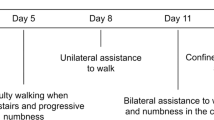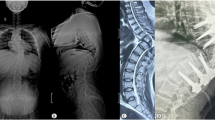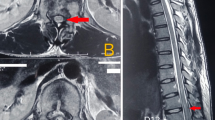Abstract
Study design:
Topical review of the literature.
Objectives:
The evaluation of patients with myelopathies requires radiological investigations; however, for the correct interpretation of the neuroimaging findings, the functional assessment of corticospinal conduction is helpful or even mandatory in many conditions. The objective of this review article was to assess the utility of the motor evoked potentials (MEPs) in diagnosis and management of the most frequent spinal cord disorders.
Setting:
Salzburg (Austria) and Merano (Italy).
Methods:
A MEDLINE search was performed using following terms: ‘motor evoked potentials’, ‘transcranial magnetic stimulation’, ‘central motor conduction’, ‘compressive myelopathy’, ‘spinal cord infarction’, ‘spinal cord injury’, ‘syringomyelia’, ‘myelitis’, ‘hereditary spastic paraparesis’, ‘subacute combined degeneration’ and ‘hepatic myelopathy’.
Results:
Central motor conduction abnormalities can be detected also in the absence of neuroradiological abnormalities—for example, in patients with subacute combined degeneration or hepatic myelopathy. In the most frequent patients with compressive myelopathies, MEPs were found to be very helpful in determining the functional significance of neuroimaging findings. MEP recording can supplement clinical examination and neuroimaging findings also in the assessment of the spinal cord injury level. In patients with spinal cord infarction, the MEP study can demonstrate spinal involvement even when radiological evidence for spinal cord damage is absent or equivocal, thus allowing an important early diagnosis.
Conclusion:
MEPs represent a highly sensitive and accurate diagnostic tool in many different spinal cord disorders. MEPs can also be useful in follow-up evaluation of motor function during treatment and rehabilitation.
Similar content being viewed by others
Log in or create a free account to read this content
Gain free access to this article, as well as selected content from this journal and more on nature.com
or
References
Di Lazzaro V, Oliviero A . Evaluation of myelopathy, radikulopathy and thoracic nerve. In: Hallett M, Chokroverty S, (eds). Magnetic Stimulation in Clinical Neurophysiology. Elsevier. 2005 pp 105–127.
Di Lazzaro V, Oliviero A, Profice P, Ferrara L, Saturno E, Pilato F et al. The diagnostic value of motor evoked potentials. Clin Neurophysiol 1999; 110: 1297–1307.
Chen R, Cros D, Curra A, Di Lazzaro V, Lefaucheur JP, Magistris MR et al. The diagnostic utility of transcranial magnetic stimulation: report of an IFCN committee. Clin Neurophysiol 2008; 119: 504–532.
Groppa S, Oliviero A, Eisen A, Quartarone A, Cohen LG, Mall V et al. A practical guide to diagnostic transcranial magnetic stimulation: a report of an IFCN committee. Clin Neurophysiol 2012; 123: 858–882.
Mills KR . Magnetic Stimulation of the Human Nervous System. Oxford University Press: Oxford. 1999.
Mills KR, Murray NM . Electrical stimulation over the human vertebral column: which neural elements are excited? Electroencephalogr Clin Neurophysiol 1986; 63: 582–589.
Banerjee TK, Mostofi MS, Us O, Weerasinghe V, Sedgwick EM . Magnetic stimulation in the determination of lumbosacral motor radiculopathy. Electroencephalogr Clin Neurophysiol 1993; 89: 221–226.
Hallett M . Transcranial magnetic stimulation and the human brain. Nature 2000; 406: 147–150.
Abbruzzese G, Dall’Agata D, Morena M, Simonetti S, Spadavecchia L, Severi P et al. Electrical stimulation of the motor tracts in cervical spondylosis. J Neurol Neurosurg Psychiatry 1988; 51: 796–802.
Maertens de Noordhout MA, Remacle JM, Pepin JL . Magnetic stimulation of the motor cortex in cervical spondylosis. Neurology 1991; 41: 75–80.
Herdmann J, Dvorak J, Bock WJ . Motor evoked potentials in patients with spinal disorders: upper and lower motor neuron affection. Electromyogr Clin Neurophysiol 1992; 32: 323–330.
Tavy DLJ, Wagner GL, Keunen RWM, Wattendorff AR, Hekster RE, Franssen H . Transcranial magnetic stimulation in patients with cervical spondylotic myelopathy: clinical and radiological correlations. Muscle Nerve 1994; 17: 235–241.
Chistyakov AV, Soustiel JF, Hafner H, Feinsod M . Motor and somatosensory conduction in cervical myelopathy and radiculopathy. Spine 1995; 20: 2135–2140.
Maertens de Noordhout AM, Myressiotis S, Delvaux V, Born JD, Delwaide PJ . Motor and somatosensory evoked potentials in cervical spondylotic myelopathy. Electroencephalogr Clin Neurophysiol 1998; 108: 24–31.
Bednarik J, Kadanka Z, Vohanka S, Novotný O, Surelová D, Filipovicová D et al. The value of somatosensory and motor evoked potentials in pre-clinical spondylotic cervical cord compression. Eur Spine J 1998; 7: 493–500.
Travlos A, Pant B, Eisen A . Transcranial magnetic stimulation for detection of preclinical cervical spondylotic myelopathy. Arch Phys Med Rehabil 1992; 73: 442–446.
Tavy DL, Franssen H, Keunen RW, Wattendorff AR, Hekster RE, Van Huffelen AC . Motor and somatosensory evoked potentials in asymptomatic spondylotic cord compression. Muscle Nerve 1999; 22: 628–634.
Di Lazzaro V, Restuccia D, Colosimo C, Tonali P . The contribution of magnetic stimulation of the motor cortex to the diagnosis of cervical spondylotic myelopathy. Correlation of central motor conduction to distal and proximal upper limb muscles with clinical and MRI findings. Electroencephalogr Clin Neurophysiol 1992; 85: 311–320.
De Mattei M, Paschero B, Sciarretta A, Davini O, Cocito D . Usefulness of motor evoked potentials in compressive myelopathy. Electromyogr Clin Neurophysiol 1993; 33: 205–216.
Deftereos SN, Kechagias EA, Panagopoulos G, Seretis A, Orphanidis G, Antoniou E et al. Localization of cervical spinal cord compression by TMS and MRI. Funct Neurol 2009; 24: 99–105.
Capone F, Tamburelli FC, Pilato F, Profice P, Ranieri F, Di Iorio R et al. The role of motor-evokes potentials in the management of cervical spondylotic myelopathy. Spine J 2013; 13: 1077–1079.
Clark AJ, Ziewacz JE, Safaee M, Lau D, Lyon R, Chou D et al. Intraoperative neuromonitoring with MEPs and prediction of postoperative neurological deficits in patients undergoing surgery for cervical and cervicothoracic myelopathy. Neurosurg Focus 2013; 35: E7.
Misawa T, Ebara S, Kamimura M, Tateiwa Y, Kinoshita T, Takaoka K . Evaluation of thoracic myelopathy by transcranial magnetic stimulation. J Spinal Disord 2001; 14: 439–444.
Chokroverty S, Deutsch A, Guha C, Gonzalez A, Kwan P, Burger R et al. Thoracic spinal nerve and root conduction: a magnetic stimulation study. Muscle Nerve 1995; 18: 987–991.
Di Lazzaro V, Pilato F, Oliviero A, Saturno E, Dileone M, Tonali PA . Role of motor evoked potentials in diagnosis of cauda equina and lumbosacral cord lesions. Neurology 2004; 63: 2266–2271.
Weidauer S, Nichtweiss M, Lanfermann H, Zanella FE . Spinal cord infarction. MR imaging and clinical features in 16 cases. Neuroradiology 2002; 44: 851–857.
Nardone R, Bergmann J, Kronbichler M, Lochner P, Caleri F, Tezzon F et al. Magnetic resonance imaging and motor-evoked potential in spinal cord infarction. Neurol Sci 2010; 31: 505–509.
Linden D, Berlit P . Spinal arteriovenous malformations: clinical and neurophysiological findings. J Neurol 1996; 243: 9–12.
Daras M, Tuchman AJ, Marks S . Central nervous system infarction related to cocaine abuse. Stroke 1991; 22: 1320–13259.
Di Lazzaro V, Restuccia D, Oliviero A, Profice P, Nardone R, Valeriani M et al. Ischaemic myelopathy associated with cocaine:clinical, neurophysiological, and neuroradiological features. J Neurol Neurosurg Psychiatry 1997; 63: 531–533.
Kalita J, Srivastava AK, Mittal P, Sharma VP, Misra UK . Evoked potential changes in ischaemic myelopathy. Electromyogr Clin Neurophysiol 2003; 43: 211–215.
Kawanishi I, Munakata H, Matsumori M, Tanaka H, Yamashita T, Nakagiri K et al. Usefulness of transcranial motor evoked potentials during thoracoabdominal aortic surgery. Ann Thorac Surg 2007; 83: 456–461.
Jacobs MJ, Mess W, Mochtar B, Nijenhuis RJ, Statius van Eps RG, Schurink GW . The value of motor evoked potentials in reducing paraplegia during thoracoabdominal aneurysm repair. J Vasc Surg 2006; 43: 239–246.
Nogues MA, Pardal AM, Merello M, Miguel MA . SEPs and CNS magnetic stimulation. syringomyelia. Muscle Nerve 1992; 15: 993–1001.
Masur H, Oberwittler C, Fahrendorf G, Heyen P, Reuther G, Nedjat S et al. The relation between functional deficits, motor and sensory conduction times and MRI findings in syringomyelia. Electroencephalogr Clin Neurophysiol 1992; 85: 321–330.
Botzel K, Witt TN . Transcranial cortical stimulation in syringomyelia: correlation with disability? Muscle Nerve 1993; 16: 537–541.
Schady W, Dick JPR, Sheard A, Crampton S . Central motor conduction studies in hereditary spastic paraplegia. J Neural Neurosurg Psychiatry 1991; 54: 775–779.
Pelosi L, Lanzillo B, Perretti A, Santoro L, Blumhardt L, Caruso G . Motor and somatosensory evoked potentials in hereditary spastic paraplegia. J Neurol Neurosurg Psychiatry 1991; 54: 1099–1102.
Manganelli F, Pisciotta C, Dubbioso R, Iodice R, Criscuolo C, Ruggiero L et al. Electrophysioligical characterisation in hereditary spastic paraplegia type 5. Clin Neurophysiol 2011; 122: 819–822.
Schüle R, Brandt E, Karle KN, Tsaousidou M, Klebe S, Klimpe S et al. Analysis of CYP7B1 in non-consanguineous cases of hereditary spastic paraplegia. Neurogenetics 2009; 10: 97–104.
Sartucci F, Tovani S, Murri L, Sagliocco L . Motor and somatosensory evoked potentials in autosomal dominant hereditary spastic paraparesis (ADHSP) linked to chromosome 2p, SPG4. Brain Res Bull 2007; 74: 243–249.
Kalita J, Misra UK . Neurophysiological studies in acute transverse myelitis. J Neurol 2000; 247: 943–948.
Leon-Sarmiento FE, Elfakhani M, Boutros NN . The motor evoked potential in AIDS and HAM/TSP: state of the evidence. Arq Neuropsiquiatr 2009; 67: 1157–1163.
Di Lazzaro V, Restuccia D, Fogli D, Nardone R, Mazza S, Tonali P . Central sensory and motor conduction in vitamin B12 deficiency. Electroencephalogr Clin Neurophysiol 1992; 84: 433–439.
Hemmer B, Glocker FX, Schumacher M, Deuschl G, Lücking CH . Subacute combined degeneration: clinical, electrophysiological, and magnetic resonance imaging findings. J Neurol Neurosurg Psychiatry 1998; 65: 822–827.
Utku U, Asil T, Balci K, Uzunca I, Celik Y . Hepatic myelopathy with spastic paraparesis. Clin Neurol Neurosurg 2005; 107: 514–516.
Nardone R, Buratti T, Oliviero A, Lochmann A, Tezzon F . Corticospinal involvement in patients with a portosystemic shunt due to liver cirrhosis: a MEP study. J Neurol 2006; 253: 81–85.
Meyer B, Zentner J . Do motor evoked potentials allow quantitative assessment of motor function in patients with spinal cord lesions? Eur Arch Psychiatry Clin Neurosci 1992; 241: 201–204.
Zentner J, Rieder G . Diagnostic significance of motor evoked potentials in space-occupying lesions of the brain stem and spinal cord. Eur Arch Psychiatry Neurol Sci 1990; 239: 285–289.
Lissens MA, Vanderstraeten GG . Motor evoked potentials of the respiratory muscles in tetraplegic patients. Spinal Cord 1996; 34: 673–678.
Zifko U, Remtulla H, Power K, Harker L, Bolton CF . Transcortical and cervical magnetic stimulation with recording of the diaphragm. Muscle Nerve 1996; 19: 614–620.
Curt A, Dietz V . Electrophysiological recordings in patients with spinal cord injury:significance for predicting outcome. Spinal Cord 1999; 37: 157–165.
Curt A, Keck ME, Dietz V . Functional outcome following spinal cord injury: significance of motor-evoked potentials and ASIA scores. Arch Phys Med Rehabil 1998; 79: 81–86.
Petersen JA, Spiess M, Curt A, Dietz V, Schubert M, EM-SCI Study Group. Spinal cord injury: one-year evolution of motor-evoked potentials and recovery of leg motor function in 255 patients. Neurorehabil Neural Repair 2012; 26: 939–948.
van Hedel HJ, Murer C, Dietz V, Curt A . The amplitude of lower leg motor evoked potentials is a reliable measure when controlled for torque and motor task. J Neurol 2007; 254: 1089–1098.
Author information
Authors and Affiliations
Corresponding author
Ethics declarations
Competing interests
The authors declare no conflict of interest.
Rights and permissions
About this article
Cite this article
Nardone, R., Höller, Y., Thomschewski, A. et al. Central motor conduction studies in patients with spinal cord disorders: a review. Spinal Cord 52, 420–427 (2014). https://doi.org/10.1038/sc.2014.48
Received:
Revised:
Accepted:
Published:
Issue date:
DOI: https://doi.org/10.1038/sc.2014.48
This article is cited by
-
Neurophysiologic evaluation of patients with cervical spondylotic myelopathy
The Egyptian Journal of Neurology, Psychiatry and Neurosurgery (2022)
-
Magnetic motor evoked potentials of cervical muscles in horses
BMC Veterinary Research (2018)
-
Benefits of Early Treatment for Patients with Hepatic Myelopathy Secondary to TIPS: A Retrospective Study in Northern China
Scientific Reports (2018)
-
The contribution of neurophysiology in the diagnosis and management of cervical spondylotic myelopathy: a review
Spinal Cord (2016)
-
Diagnostic transcranial magnetic stimulation as a prognostic tool in children with acute transverse myelitis
Spinal Cord (2016)



